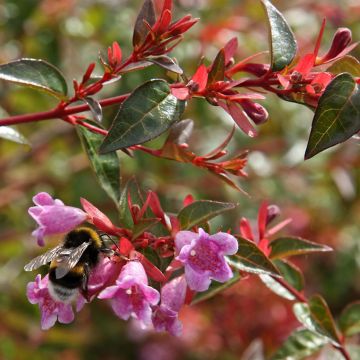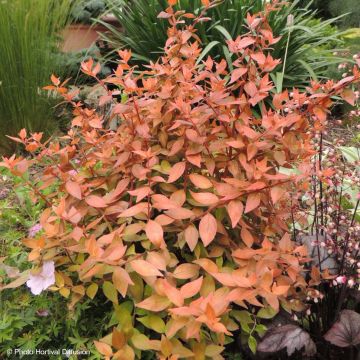

Abelia parviflora Bumblebee
Abelia parviflora Bumblebee
Abelia parviflora Bumble Bee
Chinese Abelia
Special offer!
Receive a €20 voucher for any order over €90 (excluding delivery costs, credit notes, and plastic-free options)!
1- Add your favorite plants to your cart.
2- Once you have reached €90, confirm your order (you can even choose the delivery date!).
3- As soon as your order is shipped, you will receive an email containing your voucher code, valid for 3 months (90 days).
Your voucher is unique and can only be used once, for any order with a minimum value of €20, excluding delivery costs.
Can be combined with other current offers, non-divisible and non-refundable.
Why not try an alternative variety in stock?
View all →This plant carries a 24 months recovery warranty
More information
We guarantee the quality of our plants for a full growing cycle, and will replace at our expense any plant that fails to recover under normal climatic and planting conditions.

Would this plant suit my garden?
Set up your Plantfit profile →
Description
Abelia parviflora Bumble Bee is a beautiful improvement of the species native to China, characterized by its very long flowering period and the brilliance of its flowers. This lovely variety is covered with bell-shaped, slightly scented flowers in a beautiful lilac-pink colour throughout the summer. Its reddish calyxs remain decorative for a long time on an elegant semi-evergreen foliage. This easy-to-grow abelia is a reliable choice in regions spared from very harsh winters. It deserves a place in the garden, in a flowering hedge. The Royal Horticultural Society has recognized it for its ornamental qualities and performance in the garden.
The Abelia parviflora (synonyms schumannii or longituba) 'Bumble Bee' is a beautiful European horticultural creation with somewhat obscure origins. Like all Abelia, as well as honeysuckles and Kolkwitzia amabilis, it belongs to the Caprifoliaceae family. The habit of this shrub is both bushy and slightly spreading, carried by flexible reddish-coloured branches. Its growth is quite rapid, depending on the growing conditions. At maturity, after 5 to 10 years, this abelia will reach an average size of 1.50m (4.92 ft) in all directions, with its branches tending to spread over time. Flowering occurs from July to September, earlier or later depending on the climate, on one-year-old and older branches. The buds, a slightly pinkish red, open into small campanulate flowers, 1.5cm (0.6in) wide, grouped in panicles at the axils of the leaves. The inside of the corolla is a bright mauve pink, the throat is spotted with yellow-orange on a white background, while the reverse is tinged with pale lilac pink. The reddish calyxes of the flowers persist on the branches until late in the season, long after the flowers have faded. This flowering releases a subtle and pleasant fragrance, which attracts numerous pollinating insects. The branches of the Bumble Bee abelia bear small pointed, bright green, shiny leaves opposite in pairs. They take on pretty red-orange hues in autumn and persist until early winter, as long as the frosts are not too severe. Note that this Chinese abelia prefers slightly moist, humus-rich soils. It can withstand cold temperatures, down to -12 or -15°C (10.4 or 5°F) once it is mature.
The 'Bumble Bee' abelia is very floriferous and decorative for a good part of the year. Its hardiness is quite good in well-drained soil, its growth is moderate, and it possesses a unique personality that will leave its mark on the garden. It can be integrated into a medium-sized flowering hedge, alongside buddleias, Kolkwitzia, mock oranges, Syringa microphylla 'Superba', and other ceanothuses, or in the middle of autumn flower beds, combined with asters, Japanese anemones, tricyrtis, etc. It will work wonders in an ericaceous bed with rhododendrons, autumn camellias, and other Pieris. 'Bumble Bee' also grows very well in a container, which can be placed on the terrace. This method of cultivation allows it to be sheltered in very cold regions during winter.
Abelia parviflora Bumblebee in pictures




Plant habit
Flowering
Foliage
Botanical data
Abelia
parviflora
Bumble Bee
Caprifoliaceae
Chinese Abelia
Abelia schumanii, Abelia longituba
Cultivar or hybrid
Other Abelia
View all →Planting and care
Abelia Bumble Bee has fairly good resistance to cold, down to -12/-15°C (10.4 - 5°F), and grows in any good garden soil that is sufficiently deep, well-drained, preferably not too dry, and close to neutral (without excess acidity or limestone). Give it a sunny or semi-shade exposure, sheltered from cold and dry winds. To support flowering, water abundantly every 15 days if needed. Once mature prune sparingly, just after flowering, as the flowers bloom on old wood. Regularly pinch the tips of young shoots during the growth period.
Planting period
Intended location
Care
Planting & care advice
This item has not been reviewed yet - be the first to leave a review about it.
Similar products
Haven't found what you were looking for?
Hardiness is the lowest winter temperature a plant can endure without suffering serious damage or even dying. However, hardiness is affected by location (a sheltered area, such as a patio), protection (winter cover) and soil type (hardiness is improved by well-drained soil).

Photo Sharing Terms & Conditions
In order to encourage gardeners to interact and share their experiences, Promesse de fleurs offers various media enabling content to be uploaded onto its Site - in particular via the ‘Photo sharing’ module.
The User agrees to refrain from:
- Posting any content that is illegal, prejudicial, insulting, racist, inciteful to hatred, revisionist, contrary to public decency, that infringes on privacy or on the privacy rights of third parties, in particular the publicity rights of persons and goods, intellectual property rights, or the right to privacy.
- Submitting content on behalf of a third party;
- Impersonate the identity of a third party and/or publish any personal information about a third party;
In general, the User undertakes to refrain from any unethical behaviour.
All Content (in particular text, comments, files, images, photos, videos, creative works, etc.), which may be subject to property or intellectual property rights, image or other private rights, shall remain the property of the User, subject to the limited rights granted by the terms of the licence granted by Promesse de fleurs as stated below. Users are at liberty to publish or not to publish such Content on the Site, notably via the ‘Photo Sharing’ facility, and accept that this Content shall be made public and freely accessible, notably on the Internet.
Users further acknowledge, undertake to have ,and guarantee that they hold all necessary rights and permissions to publish such material on the Site, in particular with regard to the legislation in force pertaining to any privacy, property, intellectual property, image, or contractual rights, or rights of any other nature. By publishing such Content on the Site, Users acknowledge accepting full liability as publishers of the Content within the meaning of the law, and grant Promesse de fleurs, free of charge, an inclusive, worldwide licence for the said Content for the entire duration of its publication, including all reproduction, representation, up/downloading, displaying, performing, transmission, and storage rights.
Users also grant permission for their name to be linked to the Content and accept that this link may not always be made available.
By engaging in posting material, Users consent to their Content becoming automatically accessible on the Internet, in particular on other sites and/or blogs and/or web pages of the Promesse de fleurs site, including in particular social pages and the Promesse de fleurs catalogue.
Users may secure the removal of entrusted content free of charge by issuing a simple request via our contact form.
The flowering period indicated on our website applies to countries and regions located in USDA zone 8 (France, the United Kingdom, Ireland, the Netherlands, etc.)
It will vary according to where you live:
- In zones 9 to 10 (Italy, Spain, Greece, etc.), flowering will occur about 2 to 4 weeks earlier.
- In zones 6 to 7 (Germany, Poland, Slovenia, and lower mountainous regions), flowering will be delayed by 2 to 3 weeks.
- In zone 5 (Central Europe, Scandinavia), blooming will be delayed by 3 to 5 weeks.
In temperate climates, pruning of spring-flowering shrubs (forsythia, spireas, etc.) should be done just after flowering.
Pruning of summer-flowering shrubs (Indian Lilac, Perovskia, etc.) can be done in winter or spring.
In cold regions as well as with frost-sensitive plants, avoid pruning too early when severe frosts may still occur.
The planting period indicated on our website applies to countries and regions located in USDA zone 8 (France, United Kingdom, Ireland, Netherlands).
It will vary according to where you live:
- In Mediterranean zones (Marseille, Madrid, Milan, etc.), autumn and winter are the best planting periods.
- In continental zones (Strasbourg, Munich, Vienna, etc.), delay planting by 2 to 3 weeks in spring and bring it forward by 2 to 4 weeks in autumn.
- In mountainous regions (the Alps, Pyrenees, Carpathians, etc.), it is best to plant in late spring (May-June) or late summer (August-September).
The harvesting period indicated on our website applies to countries and regions in USDA zone 8 (France, England, Ireland, the Netherlands).
In colder areas (Scandinavia, Poland, Austria...) fruit and vegetable harvests are likely to be delayed by 3-4 weeks.
In warmer areas (Italy, Spain, Greece, etc.), harvesting will probably take place earlier, depending on weather conditions.
The sowing periods indicated on our website apply to countries and regions within USDA Zone 8 (France, UK, Ireland, Netherlands).
In colder areas (Scandinavia, Poland, Austria...), delay any outdoor sowing by 3-4 weeks, or sow under glass.
In warmer climes (Italy, Spain, Greece, etc.), bring outdoor sowing forward by a few weeks.































































